5656 Sapper
Cornelius Freeman
Royal Sappers and Miners
(subsequently the Royal Engineers)
by
Lieutenant
Colonel Edward De Santis, MSCE, PE, MInstRE
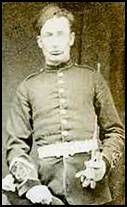
Figure 1. 5656 Sapper
Cornelius Freeman, R.E.
(Photograph in the author’s collection)
NOTE: This is an unverified photograph of Sapper Freeman, c. 1865.
1. INTRODUCTION
Unless otherwise noted, the details supplied in this narrative were
obtained from the soldier’s service papers (WO97/2835) at the Public Record
Office, Kew, Richmond, Surrey.[1]
Freeman enlisted in the Army using the given name Cornelius.
Research indicates that his name may have been John Cornelius Freeman
or Charles Cornelius Freeman. It
appears that for some reason he chose to drop the use of his first name, if
indeed he had one. The names John
Cornelius Freeman and Charles Cornelius Freeman appear in family trees
produced by other researchers, but as one looks into these family trees in
depth, one eventually arrives at the same individual; that is, a man with the
name Cornelius who served as a Sapper in the Royal Engineers.
The use of a given name in addition to Cornelius has made the tracing
of this man’s life story rather confusing at times.
For simplicity, Sapper Freeman will be referred to as Cornelius Freeman
throughout the remainder of this narrative as this is the name that appears in
his military service papers.
2. EARLY
LIFE AND FAMILY INFORMATION
Cornelius Freeman was the son of Charles Cornelius Freeman (1805-1849)
and Mary Ann Freeman, née Marshall (1805-?).
He was born on Berisford Street in the Parish of St. Mary’s in the
town of Woolwich, in the County of Kent on 7 July 1844.
St. Mary’s Parish is located east south east of the Royal Dock Yard,
north of the Royal Infantry and Royal Artillery Barracks and northwest of
Woolwich Arsenal in the heart of the Woolwich naval and military complex.[2]
It may be safe to assume that Cornelius Freeman could have been the son
of a serving soldier or an ex-soldier who was posted to or working in the
Woolwich area, although this could not be verified by records or family-tree
searches of the Freeman family. The
place of his birth and the fact that he would later enlist in the Army as a
Boy Soldier are two pieces of evidence that may validate this assumption.
1851
Census of England
|
Address:
23 Colefields, Plumstead, Kent.
|
|
Name
and Surname
|
Relation
|
Marital
Status
|
Age
|
Profession
or Occupation
|
Birthplace
|
|
Mary
Ann Freeman
(1805-?)
|
Head
|
Widow
|
46
|
Laundress
|
South
Ockendon,
Essex
|
|
Edward
Beech
(1827-?)
|
Son
|
Single
|
24
|
Journeyman
Painter
|
Hedon,
Yorkshire
|
|
James
Beech
(1835-?)
|
Son
|
Single
|
16
|
|
Lambeth,
Surrey
|
|
Maria
Beech
(1837-?)
|
Daughter
|
|
13
|
Scholar
|
Grenada,
West Indies
|
|
Cornelius
Freeman
(1844-1930)
|
Son
|
|
7
|
Scholar
|
Woolwich,
Kent
|
|
Mary
Ann Freeman
(1848-?)
|
Daughter
|
|
3
|
|
Plumstead,
Kent
|
NOTE: The dates of birth
and death for each individual are not shown on the
original census. These
have been added by the author.
Mary Ann Freeman started out life as Mary Ann Marshall.
In 1822 she married one John Beech[3]
and she and John had the three children shown in the census table above.
In 1841 they resided on New Road in Charlton-Next-Woolwich, Kent.
John Beech died sometime in the 1840s and Mary Ann married (Charles)
Cornelius Freeman on 23 October 1843 in the parish church at Charlton, Kent.[4]
The 1851 Census of the British Isles shows that a Cornelius Freeman,
age 7, was born in Woolwich, Kent and he is listed as a “scholar” in the
census return. The address shown
in the census, 23 Colefields, Plumstead, apparently no longer exists.[5]
Mary Ann Freeman is listed as a widow and head of the family, as
Charles Cornelius Freeman had died at 2 Upper Burrage Place in Plumstead on 13
October 1849.[6]
By the time of the 1861 Census of England Mary Ann Freeman, still
working as a laundress, was living at 48 Fitzroy Terrace in Plumstead.[7]
Young Cornelius was no longer living at home with his mother and
siblings. He had joined the Army
in 1858 as a Boy Soldier and was serving at Brompton Barracks in Gillingham,
Kent. He is shown in the census
for that institution (RG 9/480) as a 17-year old Private in the Corps of Royal
Sappers and Miners.
3. PHYSICAL DESCRIPTION
The following
is a description of Cornelius Freeman, taken from his Attestation papers, at
the time he enlisted in the Army in 1858:
|
Age:
|
14 years and 90 days
|
|
Height:
|
4 feet 7½ inches
|
|
Complexion:
|
Fresh
|
|
Eyes:
|
Blue
|
|
Hair:
|
Brown
|
|
Distinctive
Marks:
|
None
|
The following is a description of Cornelius Freeman at the time he was
given a medical examination in 1860:
|
Age:
|
15 years
|
|
Height:
|
5 feet ½ inch
|
|
Weight:
|
79 pounds
|
|
Small Pox
Marks:
|
None
|
|
Vaccination
Marks:
|
Left arm
|
|
When
Vaccinated:
|
1858
|
|
Hair:
|
Brown
|
|
Pulse:
|
64 beats per minute
|
|
Respiration:
|
16 inspirations per minute
|
|
Muscular
Development:
|
Moderate
|
4. ENLISTMENT AND
TRAINING
Enlistment
Cornelius Freeman enlisted in the Royal Sappers and Miners as a Boy
Soldier[8]
at Brompton Barracks, Chatham, Kent at 10:30 a.m. on 26 July 1858.[9]
He was enlisted by 1995 Sergeant James Douglas, R.E.[10]
with the promise of a free kit. As
mentioned previously, the fact that he enlisted as a Boy Soldier is
substantial evidence that he may have been the son of a soldier (or
ex-soldier). The fact that he
enlisted at Chatham, the home of the Royal Sappers and Miners, is evidence
that his father may also have been a Sapper, although no documentation
verifying this was found during the course of this research work.
Young Cornelius was required to answer a number of questions normally
put to recruits on their enlistment into the Army.
He indicated that he had no trade or calling and that he was not an
apprentice. He was, of course, not
married; he had no physical disabilities and had never been previously
rejected for naval or military service. He
also indicated that he had no prior naval or military service in the Militia,
Regular Forces or the East India Company.
Following a cursory medical examination by an Army medical officer,
administered on the same day as his enlistment, Cornelius Freeman was found to
be fit for military service. All
that remained now was for him to swear the Oath of Attestation.
Cornelius Freeman swore the Oath of Attestation before a Magistrate at
11:45 a.m. on 28 July 1858 at Rochester, Kent.
His enlistment was for a period of 15 years and 275 days.[11]
Since young Cornelius could not write, he had to make his mark on the
attestation paper (an “X”) that was witnessed by 2nd Captain T.
Herbert, R.E.[12]
Final approval for Freeman’s enlistment was given on this same date
at Chatham by Lieutenant Colonel Frederick Augustus Yorke, R.E., the Assistant
Adjutant General.[13]
Training
Cornelius Freeman remained at Chatham where he underwent training as a
Boy Soldier until 26 April 1859 when he was posted to Portsmouth to serve as a
Bugler[14]
with the 36th (Service) Company, Royal Engineers.
On
1 October 1859 the gallant services of the Corps of Royal Sappers and Miners
were rewarded at the close of the Crimean War by the grant of the title Royal
Engineers. In the London
Gazette of 17 October 1856 the change was thus announced--
“The Queen has been graciously pleased to direct that
the Corps of Royal Sappers and Miners shall henceforth be denominated the
Corps of Royal Engineers.”
This reorganization put the non-commissioned officers and
other ranks in the same Corps as the officers.
As a consequence of this royal grant the men of the rank and file were
no longer known as Privates, but Sappers; hence, Freeman would be a Sapper
when he entered the ranks at age 18.
5. ASSIGNMENTS AND
CAMPAIGN SERVICE
Portsmouth
(1859-1861)
The 36th (Service) Company was a relatively new unit, having
been formed in July of 1858. The
function of the service company was to control a number of men who were
undergoing instruction and training prior to assignment to a field unit.
As with most companies of the Royal Engineers at the time, the service
company had two buglers on its establishment.
Chatham
(1861-1862)
On 1 April of 1861 the 36th (Service) Company moved from
Portsmouth to Chatham and was redesignated the 36th (Depot)
Company. Bugler Freeman continued
to serve in the 36th Company until 1 October 1861 when he was
posted to the ranks as a Sapper in the 26th Company, R.E. at
Chatham.[15],[16]
Weymouth
(1862-1869)
The 26th Company left Chatham on 19 December 1862 and moved
to Weymouth in Dorsetshire. The 26th
Company was a field company with a mission much different than Freeman had
experienced in the service and depot companies.
His job now was to undertake field engineering tasks in support of
cavalry, artillery and infantry units when on campaign.
Malta
(1869-1872)
The 26th Company remained at Weymouth until 29 December 1869
when it sailed to Malta on board HMS Simoon.
The company, 93 men strong, arrived at Malta on 18 January 1870 and
replaced the 27th Company, R.E.
The unit was billeted at St. Francis Barracks in Floriana.
During the time that Freeman served at Malta there were many health
problems in the ranks of the Royal Engineers.
Hospital admissions were high due to the men not be acclimatized to the
weather, as well as numerous cases of enteric fever and illnesses due to
drunkenness.
Sapper Freeman served on Malta until 1872 when it appears that he was
reassigned to the 9th Field Company, R.E.[17]
On 1 June 1870 while on the island of Malta, Sapper Freeman re-engaged
to complete 21 years of service with the Colours.[18]
Bermuda
and Nova Scotia (1872-1880)
Freeman left Malta on 18 October 1872 to join his new company.
He arrived on the island of Bermuda on 30 November 1872.
His service for the next 8 years consisted of alternating postings to
Bermuda and Halifax, Nova Scotia, depending upon the season of the year.
The company appeared to spend the winter months on Bermuda and the
spring, summer and autumn months in Halifax.
On Bermuda the Royal Engineers were an important part of the Garrison,
improving pre-existing fortifications and batteries, like Fort St.
Catherine's, building new ones, surveying the island, building a causeway to
link St. George's Island to the Main Island, a lighthouse at Gibb's Hill, and
various other facilities. A system of military roads was built, also, as the
rudimentary roads that had existed before had been used by islanders primarily
to take the shortest route to the shore, with most passengers and wares moved
around the archipelago by boats.
Shorncliffe
(1880-1883)
On 19 June 1880 Sapper Freeman was posted back to England where he
rejoined the 26th Field Company at Shorncliffe in Kent.[19]
He served at home until 1883 when he took his discharge from the Army.
6. PROMOTIONS AND CONDUCT
a.
Promotions: Sapper
Cornelius Freeman received no promotions during his time in service.
This may be explained by his lack of education and perhaps an
intelligence deficiency.
b.
Conduct: In
January 1860, while still serving as a Boy Soldier, Cornelius Freeman’s
habits were described as “regular” and his conduct as “very good.”
He was posted to the ranks as a Sapper upon reaching his 18th
birthday and he remained a Sapper during his entire time in the Army.
He received the following Good Conduct Badges during his time in
service:[20]
Date of Award
|
Good
Conduct Badge
|
|
29 April
1865
|
Authorized
Good Conduct Pay at 1.d per day
|
|
29 April
1870
|
Authorized
Good Conduct Pay at 2.d per day
|
|
29 April
1874
|
Authorized
Good Conduct Pay at 3.d per day
|
|
29 April
1878
|
Authorized
Good Conduct Pay at 4.d per day
|
|
29 April
1883
|
Authorized
Good Conduct Pay at 5.d per day
|
Although he
received the Good Conduct Badges and medal indicated above, his conduct was
not always above reproach. His
name appears five times in the Company Defaulter’s Book for the infractions
indicated in the table below.
Date of Infraction
|
Nature
of Infraction
|
Punishment
|
|
19
February 1861
|
|
Admonished
|
|
5 July
1861
|
Drunk in a barracks
room at Chatham and abusive to a Corporal
|
Confined to a guard
room cell for 48 hours, confined to barracks for 14 days, no leave for
3 months
|
|
6 April
1867
|
Drunk in
the street
|
Admonished
|
|
18
September 1867
|
Absent from working
parade from 12:50 p.m. until 8:45 a.m. the following day.
|
Confined to barracks
for 7 days, no leave for 3 months
|
|
23 May
1872
|
Absent
from tattoo for 10 minutes
|
Admonished
|
It would appear that Sapper Freeman may have had a drinking problem.
Not only was he found drunk on two instances, but his absence from duty
also may have been attributable to excessive drinking.
During the Victorian period the British Army was rather forgiving of a
soldier’s minor infractions. He
could commit the offenses shown in the table above and yet still be awarded
Good Conduct Badges if a significant period of good conduct followed such
offenses.
7.
EDUCATION AND QUALIFICATIONS
a.
Education: Sapper
Freeman earned no Certificates of Education during his time in service.
This lack of education is probably the reason that Freeman was never
promoted above the rank of Sapper.[22]
He was not able to write in 1858 when he enlisted and probably could
not read. This certainly indicates
that his designation as a “scholar” in the 1851 census surely was an
exaggeration. Apparently his
education as a child was lacking and he made little, if any effort, to improve
himself while in the Army.
b.
Qualifications: Sapper
Freeman earned the following qualifications during his time in the Army:
Date of Qualification
|
Qualification
Earned
|
|
26 April
1859
|
Appointed
as a Bugler
|
|
1
October 1861
|
Posted
to the ranks as a Sapper
|
|
30
November 1866
|
Qualified
as a Mason
|
8. MEDICAL INFORMATION
The following
medical information was taken from Sapper Freeman’s service records during
his time in the Arny:
Location
|
Date
of Admission
|
Ailment
|
Period
of Hospitalization or Treatment
|
|
Weymouth,
Dorsetshire
|
16 July
1864
|
Gonorrhea
|
Admitted
to hospital. Released from
hospital on 6 August 1864.
|
|
Weymouth,
Dorsetshire
|
27
February 1868
|
Contusion
of the knee |
Admitted
to hospital after an accident. Released
from hospital on 16 March 1868.
|
|
Malta
|
13 July
1871 |
Preventive
Medicine
|
Revaccinated
against small pox.
|
|
Malta
|
16
November 1871
|
Sprain
|
Admitted
to hospital after an accident. Released
from hospital on 28 November 1871.
|
|
Malta
|
2
February
1872
|
Boil
|
Admitted
to hospital. Released from
hospital on 8 February 1872.
|
NOTE: He was treated for
gonorrhea only five months before his first marriage.
See Section 9 below.
9. MARRIAGE AND PERSONAL
INFORMATION
First
Marriage (1864)
Sapper Cornelius Freeman married Louisa Jane Hansford (1844-1877) at
the Register Office in Weymouth, Dorsetshire on 19 December 1864.[23]
He was only 20 years old when he married and he married without leave;
that is, without the permission of his commanding officer.[24]
As a young soldier earning Sapper’s pay, this would have put
considerable stress on him and his young wife.
Marrying without the permission of the commanding officer meant that he
and his wife would not have been put on the unit’s married rolls and
therefore they would not have been entitled to any benefits normally given to
soldiers on the married rolls. Normally
a 20-year old Sapper would not have been given leave to marry as this was
normally granted to non-commissioned officers.
The Freeman’s first child, Florence, was born at Fort Nothe in
Weymouth on 15 September 1869. Fort
Nothe was part of the coastal defenses built between 1860 and 1872 by the 26th
Company of the Royal Engineers to protect Portland and Weymouth Harbours, with
Portland then becoming an important Royal Navy base. Shaped like the letter D,
the fort was built with bomb-proof casemates and deep magazines.
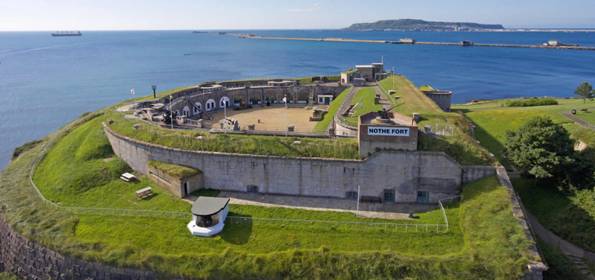
Figure 2. Fort Nothe,
Weymouth, Dorsetshire.
(Photograph courtesy of Nothe Fort)
Louisa Freeman and their children accompanied Sapper Freeman from
England to Malta in 1869 and thence to Bermuda in 1872.
The Freemans second child, Kate, was born in Bermuda in 1873 and their
third child, Robert, also was born there in 1875.
In 1876 the Freemans went with him to Halifax, Nova Scotia where the
Army finally recognized their marriage and Mrs. Freeman was placed on the
married rolls on 14 August 1876. After
all the hardships she endured while living in the barracks with her husband
and caring for their small son, Louisa Freeman was not to enjoy her new-found
place on the married rolls for very long.
She died at Halifax, Nova Scotia on 6 April 1877; not even eight months
after the Army formally recognized their marriage.
It is not known how Sapper Freeman cared for his children as he
continued to serve in Bermuda and Canada until 1880.
It is likely that they were sent home to England to live with
relatives.
Second
Marriage (1880)
Sapper Freeman returned to England in 1880 and in that same year he
married a second time, and again without leave.
His bride was Miss Rebecca Falkner of Weymouth, Dorsetshire.
The certificate below clearly shows that the groom was a Sapper Charles
Cornelius Freeman, a widower, aged 34, the son of a deceased Mason by the name
of Charles Cornelius Freeman. Although
his service papers only show his name as Cornelius Freeman, he chose to use
the name Charles Cornelius Freeman on this marriage certificate.
What his true name was is a mystery that only gets more complicated as
more documents are uncovered.

Figure 3. The Marriage
Certificate of Charles Cornelius Freeman and Rebecca Falkner, dated 24 August
1880 at Weymouth, Dorset.
(Image courtesy of Ancestry.com)
The 1881 Census of England, taken at Shorncliffe Camp, provides the
following information regarding the Freeman family:
1881
Census of England
|
Address:
Shorncliffe Camp, nr. Cheriton, Kent.
|
|
Name
and Surname
|
Relation
|
Marital
Status
|
Age
|
Rank,
Profession or Occupation
|
Where
Born
|
|
Cornelius
Freeman
|
Head
|
Married
|
37
|
Sapper,
R.E.
|
Woolwich,
Kent
|
|
Rebecca
Freeman
|
Wife
|
Married
|
32
|
|
Weymouth,
Dorset
|
|
Florence
Freeman
|
Daughter
|
|
11
|
Scholar
|
Bermuda
|
|
Kate
Freeman
|
Daughter
|
|
8
|
Scholar
|
Bermuda
|
|
Robert
Freeman
|
Son
|
|
6
|
Scholar
|
Bermuda
|
All of the children shown above in the 1881 census were the
children that Cornelius Freeman had with his first wife, Louisa Jane.
Cornelius and Rebecca had five children: Arthur Carter Freeman
(1881-1971); Walter Freeman (1883-?); Amy Mary Freeman (1884-1975); James
Freeman (1886-1941) and Benjamin Frederick Victor Freeman (1887-1981).
These children appear in the 1891 Census of England, after Freeman had
left the Army.
1891
Census of England
|
Address:
Gillingham, Kent.
|
|
Name
and Surname
|
Relation
|
Marital
Status
|
Age
|
Rank,
Profession or Occupation
|
Where
Born
|
|
Cornelius
Freeman
|
Head
|
Married
|
47
|
Canteen
Steward(1)
|
Woolwich,
Kent
|
|
Rebecca
Freeman
|
Wife
|
Married
|
42
|
|
Weymouth,
Dorset
|
|
Robert
Freeman(2)
|
Son
|
|
16
|
Scholar
|
Bermuda
(British Subject)
|
|
Arthur
Freeman(3)
|
Son
|
|
9
|
|
Shorncliffe,
Kent
|
|
Walter
Freeman
|
Son
|
|
8
|
|
Chatham,
Kent
|
|
Amy
Freeman(4)
|
Daughter
|
|
6
|
|
Chatham,
Kent
|
|
James
Freeman
|
Son
|
|
5
|
|
Chatham,
Kent
|
|
Frederick
Freeman(5)
|
Son
|
|
3
|
|
Chatham,
Kent
|
NOTES:
(1)
After leaving the Army in 1883 Cornelius
Freeman took a job as a Canteen Steward probably at or
near Brompton Barracks.
(2)
Robert Freeman, the son by Cornelius’s
first wife, Louisa, was still living with his father and
his step-mother in 1891.
Florence and Kate would have been 21 and 18 years
old, respectively, in 1891.
They were no longer living with their father and
step-mother.
(3)
Arthur’s full name was Arthur Carter
Freeman.
(4)
Amy’s full name was Amy Mary Freeman.
(5)
Frederick’s full name was actually
Benjamin Frederick Victor Freeman.
10.
DISCHARGE
Sapper Cornelius Freeman was discharged from the Army on 1 May 1883 on
the termination of his second period of limited engagement.
His total service was reckoned as shown in the tables below:
Location
|
Period
of Service
|
|
Home
|
28 July
1858 – 28 December 1869
|
|
Malta
|
29
December 1869 – 17 October 1872
|
|
Bermuda
|
18
October 1872 – 8 April 1876
|
|
Halifax,
Nova Scotia
|
9 April
1876 – 25 November 1877
|
|
Bermuda
|
26
November 1877 – 2 May 1878
|
|
Halifax,
Nova Scotia
|
3 May
1878 – 12 November 1878
|
|
Bermuda
|
13
November 1878 – 1 May 1879
|
|
Halifax,
Nova Scotia
|
2 May
1879 – 18 June 1880
|
|
Home
|
19 June
1880 – 1 May 1883
|
Location
|
Period
of Service
|
|
Home
Service
|
14 years
and 106 days
|
|
Service
Abroad
|
10 years
and 172 days
|
Total Service
|
24 years
and 248 days
|
Sapper Freeman did not have any campaign service, therefore his only
medal entitlement is the Army Long Service and Good Conduct Medal.
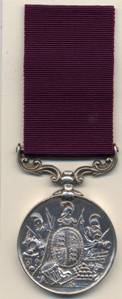

Figures
4 and 5. The Obverse and Reverse
of Freeman’s
Army Long Service and Good Conduct Medal.
(Photographs from the author’s collection)
The medal is named to Freeman in upper case engraved script as follows:
5656.SAPPER
C. FREEMAN.R.E.
11. POST SERVICE LIFE
Cornelius Freeman’s family and post service life can be traced by
examining the census returns for 1901 and 1911.
1901
Census of England
|
Address:
New Brompton, Gillingham, Kent.
|
|
Name
and Surname
|
Relation
|
Marital
Status
|
Age
|
Rank,
Profession or Occupation
|
Where
Born
|
|
Cornelius
Freeman
|
Head
|
Married
|
57
|
Stonemason
|
Woolwich,
Kent
|
|
Rebecca
Freeman
|
Wife
|
Married
|
53
|
|
Weymouth,
Dorset
|
|
Arthur
Freeman
|
Son
|
|
19
|
Carpenter
|
Shorncliffe,
Kent
|
|
Walter
Freeman
|
Son
|
|
17
|
Boilermaker’s
Labourer
|
Old
Brompton,
Kent
|
|
James
Freeman
|
Son
|
|
14
|
Plumber’s
Apprentice
|
Gillingham,
Kent
|
|
Frederick
Freeman
|
Son
|
|
13
|
|
Gillingham,
Kent
|
|
Amy
Freeman
|
Daughter
|
|
15
|
|
Old
Brompton,
Kent
|
NOTES:
(1)
Robert Freeman, 26 years of age in 1901, had
left the household and was out on his own.
(2)
The birthplaces of some of the children had
been changed, but in reality Chatham, Gillingham and Old
Brompton were contiguous and the names probably were used
interchangeably.
(3)
Cornelius Freeman had given up his job as a
Canteen Steward and had taken a position as a Stonemason,
a trade in which he was qualified as a result of his
military training.
(4)
Arthur and Walter had acquired trades and
James was in the process of acquiring a trade by virtue of
his apprenticeship. As
they were unmarried and living in their father’s home,
they undoubtedly were providing additional income for the
family.
1911
Census of England and Wales
|
Address:
4 Britton Farm Street, Gillingham, Kent.
|
|
Name
and Surname
|
Relation
|
Marital
Status
|
Age
|
Rank,
Profession or Occupation
|
Where
Born
|
|
Cornelius
Freeman
|
Head
|
Married
|
57
|
Canteen
Steward
|
Woolwich,
Kent
|
|
Rebecca
Freeman
|
Wife
|
Married
|
56
|
|
Weymouth,
Dorset
|
|
Amy
Mary Freeman
|
Daughter
|
|
25
|
|
Chatham,
Kent
|
|
Benjamin
F.V. Freeman
|
Son
|
|
23
|
Postman
|
Chatham,
Kent
|
NOTES:
(1)
Cornelius had left his position as a
Stonemason and had returned to his job as a Canteen
Steward.
(2)
Only Amy and Benjamin (Frederick) remained
with their parents in 1911.
(3)
The address, 4 Britton Farm Street, could
not be located on Google Earth in Gillingham.
Freeman was a Mason and a member of the Brownrigg Lodge of Unity (Lodge
Number 1424) located in Chatham, Kent.[25]
He became a member of that Lodge on 10 December 1884 after transferring
from Royal Standard Lodge Number 398 in Halifax, Nova Scotia.
Cornelius Freeman died in Medway, Kent in September of 1930 at the age
of 86.
Benjamin Frederick Victor Freeman
When the Great War broke out in 1914 Freeman’s son Benjamin was 26
years old. Benjamin was serving as
a Private (Regimental Number 3605) in the 8th (City of London)
Battalion, The London Regiment (Post Office Rifles), Territorial Force when
the war started. When his unit was
called up for active service his Regimental Number was changed to 37410.
He was sent to France and Flanders on 19 December 1916 and returned
home on 13 September 1917, presumably due to ill health.[26]
Benjamin’s Great War Medal Index Card (MIC) indicates that he was
awarded the British War Medal, Victory Medal and a Silver War Badge.
The Silver War Badge roll shows that Benjamin Freeman enlisted in the
Army on 18 April 1915 and that he was discharged on 19 February 1918.
The reason for the award of the badge and the cause of his discharge is
shown on the roll as sickness. His
badge number was 321.324.
Benjamin is the only one of Cornelius Freeman’s sons that could be
identified as serving in the Great War of 1914-1918. His brother James would
have been 27 years old in 1914 and of an age eligible to serve.
However, too many men by the name of James Freeman served in the war
and this research project could not determine which man might have been the
son of Cornelius Freeman, assuming that James did serve during the war.
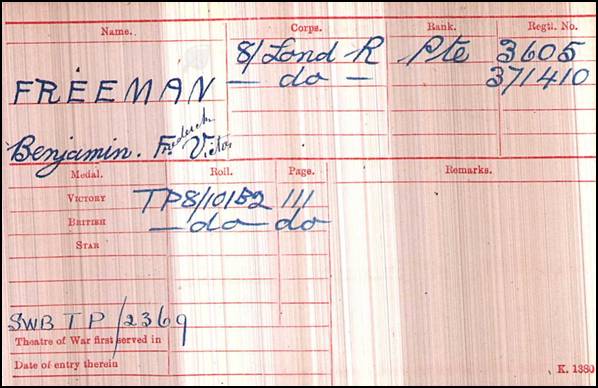
Figure
6. The Medal Index Card of
Benjamin Frederick Victor Freeman.
(Image courtesy of Ancestry.com)
The Post Office Rifles served with distinction in the Great War. They
arrived in France on 18 March 1915. By the end of the war, 1,800 men from the
Post Office Rifles would be dead and 4,500 more would be wounded.
After the outbreak of the war, the existing units of the Territorial
Force each formed duplicate (or "second line") units. The existing
Post Office Rifles was redesignated as the 1/8th Battalion, London Regiment
when a second Post Office Rifles battalion, the 2/8th London, was formed in
September 1914 In 1915 a third line battalion, the 3/8th was formed.
Between them, the three battalions earned 19 battle honours.
At the Capture of Wurst Farm, in September 1917, the 2/8th lost over
half its fighting strength, dead or wounded, but its men were awarded a total
of 40 gallantry medals. These included a Victoria Cross won by Sergeant A. J.
Knight, making him the only Post Office Rifleman to win this honour.
The battle honours awarded to the 8th (City of London) Battalion, The
London Regiment (Post Office Rifles) for the Great War were announced in March
1924. Ten honours (shown in bold type) were selected by the regiment to be
displayed on the King's Colours:
Festubert, 1915; Loos; Somme 1916, '18; Flers-Courcelette;
Le Transloy; Bullecourt; Messines, 1917; Ypres, 1917; Menin Road;
Passchendaele; Cambrai, 1917; St. Quentin; Bapaume, 1918; Amiens; Albert,
1918; Hindenburg Line; Épehy;
Pursuit to Mons; France and Flanders 1915–'18.
|
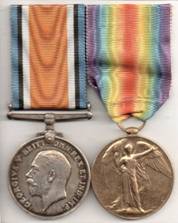
Figure
7. The British War Medal
and Victory Medal.
The
medals to which Benjamin Freeman is entitled for Great War Service.
NOTE:
These are not his medals.
|
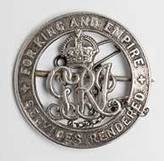
Figure
8. The Silver War Badge.
Benjamin
Freeman was entitled to this badge for his service during the Great
War.
NOTE:
This is not his badge.
|
The whereabouts of Benjamin Freeman’s medals are badge are unknown.
ADDENDUM
NO. 1
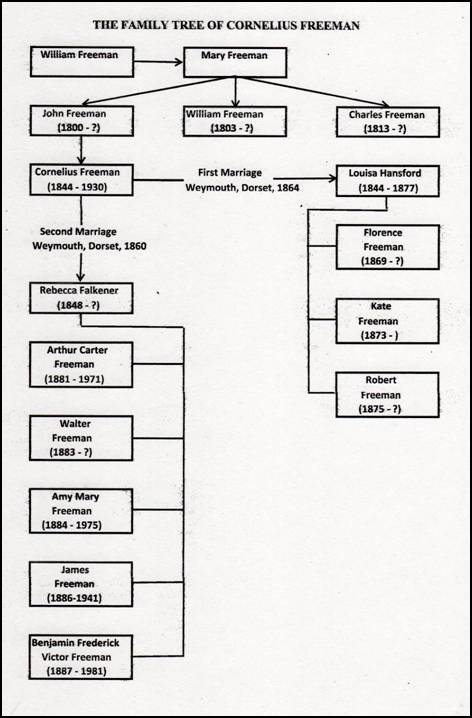
ADDENDUM NO. 2
Descendants Of
John Freeman
[The following
information was kindly provided by Mrs. Pamela Wooley, a fourth generation
descendent of Cornelius (John) Freeman]
First
Generation
1. John Freeman was born about
1803 in Huntingdonshire.
John married Elizabeth about
1830. Elizabeth was born about 1809 in Bridge, Yorkshire.
They had the following children:
2M i. William Henry Freeman was
born in 1833 in Bermuda, West Indies.
3M ii. George Freeman was born
in 1837 in Woolwich, Kent.
+ 4M iii. John Cornelius Freeman
was born on 27 Apr 1844.
5 F iv. Mary Ann Freeman was
born in 1846 in Charlton.
6M v. Charles Freeman was born
in 1848 in Woolwich, Kent.
7 M vi. Arthur Freeman was born
in 1850 in Woolwich, Kent.
Second
Generation
4. John Cornelius Freeman (John)
was born on 27 Apr 1844 in Woolwich, Kent.
John married (1) Louisa Hansford
in 1864 in Weymouth, Dorset. Louisa died on 6 Apr 1877 in Halifax, Nova
Scotia.
They had the following children:
8 M i. Charles Cornelius Freeman
was born in Weymouth, Dorset. He was christened on 24 Dec 1865 in Holy Trinity
Church, Weymouth, Dorset.
9 F ii. Emily Louisa Freeman was
born in Weymouth, Dorset. She was christened on 5 Sep 1867.
10 F iii. Florence Freeman was
born in Weymouth, Dorset. She was christened on 30ct 1869.
11 F iv. Kate Freeman was born
in 1873 in Bermuda.
12 M v. Robert Freeman was born
in 1875 in Bermuda.
John married (2) Rebecca Falkner
in 1880 in Weymouth, Dorset. Rebecca was born in 1849 in Weymouth, Dorset.
They had the following
children:
+ 13 M vi. Arthur Freeman was
born in 1882.
14 M vii. Walter Freeman was
born in 1884 in Old Brompton, Gillingham, Kent.
15 F viii. Amy Freeman was
born in 1886 in Old Brompton, Gillingham, Kent.
16 M ix. James Freeman was
born in 1887 in Gillingham, Kent.
17 M x. Fred Freeman was
born in 1888 in Gillingham, Kent.
Third
Generation
13. Arthur Freeman (John
Cornelius, John) was born in 1882 in Sandgate, Kent.
Arthur married Florence Kate
Walters about 1908 in Gillingham, Kent.
They had the following children:
+ 18 M i. Donald Freeman was
born on 16 Dec 1909. He died on 15 Jan 1976.
Fourth Generation
18. Donald Freeman (Arthur, John
Cornelius, John) was born on 16 Dec 1909 in 91 Imperial Road, Gillingham,
Kent, England. He died on 15 Jan 1976 in All Saints Hospital, Chatham, Kent,
England.
Donald married Ida Lucy
Staniland on 1 Sep 1930 in St Mark's Church, Gillingham, Kent, England. Ida
was born on 7 Nov 1908 in Gillingham, Kent. She died on 9 Jan 2002 in Corby,
Northamptonshire. She was buried on 16 Jan 2002 in Kettering Crematorium,
Northamptonshire.
They had the following children:
19 F i. Maureen Freeman was born
in Nov 1930 in Gillingham, Kent.
20 F ii. Ruth Freeman was born
in Aug 1932 in Gillingham, Kent.
21 M iii. Douglas Clifford
Freeman was born in Nov 1933 in Gillingham, Kent.
+ 22 F iv. Sylvia Shirley
Freeman was born in Nov 1934.
23 M v. Ken Freeman was born in
Mar 1937 in Gillingham, Kent.
Fifth
Generation
22. Sylvia Shirley Freeman
(Donald, Arthur, John Cornelius, John) was born in Nov 1934 in Gillingham,
Kent.
Sylvia married (1) John William
Roberts in 1955. John was born in 1934.
They had the following children:
24 F i. Yvonne Ann Roberts was
born in Oct 1956 in Gillingham, Kent, England.
25 F ii. Yvette Roberts was born
in Dec 1961 in Slough, Buckinghamshire, England. She died in 1977 in Scotland.
26 F iii. Michelle Roberts was
born in Mar 1966 in Chiswick, London, England.
Sylvia married (2) Geoffrey
Arthur Springett never married. Geoffrey was born on 5 Nov 1947 in County
Hospital, Pembury, Kent, England. He died on 28 Mar 1991 in Rainham, Kent,
England. He was buried on 11 Apr 1991 in Medway Crematorium, Chatham, Kent,
England.
They had the following children:
27 F iv. Jennifer Springett was
born on 8 Dec 1970 in All Saints Hospital, Chatham, Kent, England. She was
stillborn in All Saints Hospital, Chatham, Kent, England.
28 F v. Pamella Jane Springett
was born on 30 Sep 1971 in All Saints Hospital, Chatham, Kent, England.
Pamella married Tony Woolley on
13 Jun 1992 in St Margaret's Church, Rochester, Kent. Tony was born on 6 May
1962 in Rochester, Kent.
REFERENCES:
1.
Books
a.
COCKERILL, A.W. Sons
of the Brave: The Story of Boy Soldiers. Leo
Cooper, London, 1984.
b.
CONOLLY, T.W.J. Roll
of Officers of the Corps of Royal Engineers From 1660 to 1898.
The Royal Engineers Institute, Chatham, Kent, 1898.
c.
FARWELL, B. Mr.
Kipling’s Army: All the Queen’s Men. W.W.
Norton & Company, New York, 1981.
d.
GRIERSON, J.M. Scarlet
Into Khaki: The British Army on the Eve of the Boer War.
Greenhill Books, London, 1988.
e.
PORTER, W. The History of the
Corps of Royal Engineers. Volume
II. The Institution of Royal
Engineers, Chatham, Kent, 1952.
f.
SKELLEY, A.R. The Victorian Army
at Home: The Recruitment and Terms and Conditions of the British Regular,
1859-1899. McGill-Queen’s
University Press, Montreal, 1977.
2. Census
a.
1851 Census of England (H.O. 107/1590).
b.
1861 Census of England (R.G. 9/480).
c.
1881 Census of England (R.G. 11/897).
d.
1891 Census of England (R.G. 12/666).
e.
1901 Census of England (R.G. 13/734).
f.
1911 Census of England and Wales (R.G. 14/3942).
3. Documents
a.
Certified Copy of a Marriage Certificate, General Register
Office, MXD 248450, 24 October 1843.
b.
Certified Copy of a Marriage Certificate, General Register
Office, MXD 434111, 19 December 1864.
4. Family Trees
a.
First Generation: Descendants of John Freeman (1803), LDS
Church.
b.
Second Generation: Descendants of John Freeman (1844), LDS
Church.
c.
Third Generation: Descendants of John Freeman (1882), LDS
Church.
d.
Fourth Generation: Descendants of John Freeman (1909), LDS
Church.
e.
Fifth Generation: Descendants of John Freeman (1934), LDS
Church.
f.
Harris-Flitcroft Family Tree.
https://www.ancestry.com/family-tree/person/tree/14583600/person/18014629218/facts?_phsrc=iWN5131&_phstart=successSource
g.
Freeman Family Tree.
https://www.ancestry.com/family-tree/person/tree/2202314/person/-1854317928/facts
5. Genealogical
Sources
a.
Vital Records Index, British Isles, Christening, 1538 to 1876,
The Church of Jesus Christ of Latter-day Saints, 1998.
b.
Vital Records Index, British Isles, Christening, 1836 to 1880,
The Church of Jesus Christ of Latter-day Saints, 2001.
c.
Pallot’s Marriage Index for England, 1780-1837.
6. Internet Web Sites
a.
UK,
Royal Hospital Chelsea Pensioner Admissions and Discharges, 1715-1925
-
Nothe Fort
https://nothefort.org.uk/
c.
Regiments of the Malta Garrison (Royal Engineers)
https://www.maltaramc.com/regmltgar/royalen.html
d.
d.
Lane’s Masonic Records
https://www.dhi.ac.uk/lane/record.php?ID=2953
7. London
Gazette
a. London Gazette, 10 July 1855.
b. London Gazette, 17 October 1856.
8. Maps
a.
BARTHOLOMEW, J. Reference
Atlas of Greater London. John
Bartholomew & Son Ltd., Edinburgh, 1957.
b. MICROSOFT EXPEDIA
MAPS. http:\www.expediamaps.com








